

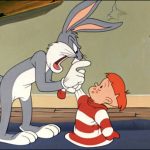
Abrasive, ill-behaved kids were a staple in classic cartoons decades before the South Park gang, Bart Simpson, or Universal’s Problem Child. It’s nice to know that every generation of animation fans has had its rotten apples.
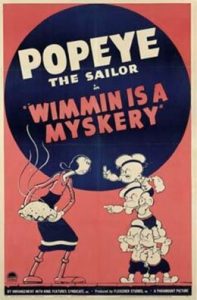 Let’s go back to 1940 and the black-and-white Popeye short Wimmin is a Myskery. This cartoon introduced Popeye’s nephews, Pepeye (Poopeye in later cartoons), Pupeye, Pipeye, and Peepeye. The character designs were likely by Charlie Thorson. The credited director is Dave Fleischer, but it was actually Willard Bowsky, who also animated the key scenes. Ted(d) Pierce, a standout writer for Fleischer and Warner Bros, penned the story. In this short, an uncredited Margie Hines plays Olive, while Jack Mercer’s sped-up vocals portray the nephews.
Let’s go back to 1940 and the black-and-white Popeye short Wimmin is a Myskery. This cartoon introduced Popeye’s nephews, Pepeye (Poopeye in later cartoons), Pupeye, Pipeye, and Peepeye. The character designs were likely by Charlie Thorson. The credited director is Dave Fleischer, but it was actually Willard Bowsky, who also animated the key scenes. Ted(d) Pierce, a standout writer for Fleischer and Warner Bros, penned the story. In this short, an uncredited Margie Hines plays Olive, while Jack Mercer’s sped-up vocals portray the nephews.
While Popeye awaits an answer to his marriage proposal to Olive Oyl, Olive goes to bed and dreams of her marriage to Popeye. It turns out to be a nightmare in which Popeye does not appear at all. Instead, the nasty nephews wreck her kitchen, smash the ceiling, and steal a pie intended for Popeye by awkwardly disguising themselves as the sailor. When caught, they get a mass spanking with a broom, but then eat spinach and turn the tables on Olive. The initial revenge scene was possibly the work of animator Joe D’Igalo, as Olive appears to have eyes with actual pupils.
The hapless mom is flipped, spun, rocketed down a stair rail, and bounced off furniture after being used as a jump rope. This rapid, violent scene awakens Olive, who finds Popeye at her door awaiting her answer. She replies that she wouldn’t marry him if he were the last man on Earth and smashes a plate over his head!
• You can watch this cartoon on DailyMotion.
That’s nothing compared to what Porky Pig is in for in the 1944 wartime short Brother Brat. Director Frank (“Tish-Tash”) Tashlin and Storyman Melvin (“Tubby”) Millar teamed up to subject Porky to Baby Butch, one of the most savage brats ever to ravage a cartoon.
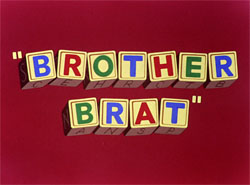 After a stylized opening (narrated by Robert C. Bruce) illustrating how women have gone to the factories to produce armaments for WWI, but there is a problem: “Where the heck to put the kids while she’s working?”
After a stylized opening (narrated by Robert C. Bruce) illustrating how women have gone to the factories to produce armaments for WWI, but there is a problem: “Where the heck to put the kids while she’s working?”
So it goes for one hefty welder at Blockheed Aircraft (Bea Benederet channeling singer/actress Cass Dailey). When Porky Pigs arrives to babysit, she hands him a book on Child Psychology (by Pistol P. Momma), literally flies off to her job, and leaves him to tend to the infant “Percy”. Upon meeting the child in his pram, Porky gets a deck of cards slammed down his throat and then painfully learns that the kid’s name is “Butch” after being mocked and having an anvil dropped on his head that crashes him through several floors to the basement.
The book advises Porky to “Give baby a cat and watch his little puss light up”. Porky does, with a gag typical of Tashlin: “Play with this k-k-k-c-c-, ah, pussy.” There is a pause, and then Porky winks at the viewers and says “p-pet.” This would be Tashlin’s final cartoon at Warner, and he may have been sporting with the censors. It would not be the last erotic gag in the short, since after Butch uses the poor cat as a jump rope, Porky catches Butch lustily reading Exquire Junior, which features female infants posed in provocative pin-up style.
When Porky tells Butch that he is too young to be reading such magazines, Butch lunges and bites Porky’s finger. In a magnificent display of animation by Art Davis, it seems like there are multiple images of Butch as Porky tries to shake the infant off.
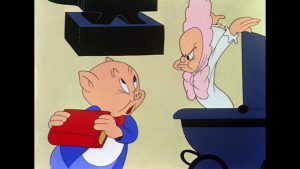 Porky does, flinging the baby into the kitchen and a heap of pots and pans. Butch emerges as a caricature of Winston Churchill giving the “V” sign with a stirring speech. He also grabs a meat cleaver. Despite the learned child psychology book’s advice (“Do not hold a grudge – the kid’s ready to bury the hatchet”), Porky desperately dodges the cleaver. The following scenes are harrowing in their sheer, malevolent violence. Butch finally pursues Porky (and the cat seen earlier) in a warp-speed circular chase.
Porky does, flinging the baby into the kitchen and a heap of pots and pans. Butch emerges as a caricature of Winston Churchill giving the “V” sign with a stirring speech. He also grabs a meat cleaver. Despite the learned child psychology book’s advice (“Do not hold a grudge – the kid’s ready to bury the hatchet”), Porky desperately dodges the cleaver. The following scenes are harrowing in their sheer, malevolent violence. Butch finally pursues Porky (and the cat seen earlier) in a warp-speed circular chase.
Just then, Mom comes home and beholds the carnage. She scolds Porky, “Didn’t you use the book?” Porky stammers that he did, but it didn’t work. Mom tells Porky he didn’t use it right while smacking the book across Percy’s bottom.
This cartoon is one of the few in which Porky wears pants. Carl Stalling’s score features several ironic variations of “Twinkle Twinkle Little Star.” Eight animators assisted Davis, including Cal Dalton, who likely animated the poor cat.
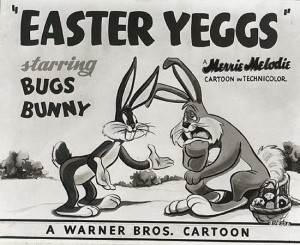 Our final brat is well-known and beloved by lovers of classic Bugs Bunny cartoons. That would be the monster child from the 1947 short Easter Yeggs directed by Robert McKimson, who also designed the character. A sign on his house refers to him as “The Dead-End Kid.” He is diminutive, with a red Moe Howard bowl cut and freckles, dressed in a red and white striped nightshirt about five sizes too big.
Our final brat is well-known and beloved by lovers of classic Bugs Bunny cartoons. That would be the monster child from the 1947 short Easter Yeggs directed by Robert McKimson, who also designed the character. A sign on his house refers to him as “The Dead-End Kid.” He is diminutive, with a red Moe Howard bowl cut and freckles, dressed in a red and white striped nightshirt about five sizes too big.
He initially appears in an apple crate, teething with a pistol. In this scene, animated by Izzy Ellis, Bugs, posing as the Easter Bunny, offers him an egg. The kid smashes it in Bugs’s face and states his signature line: “I wanna Easter egg!” The kid savagely bites Bug’s ankle. When Bugs tries to defend himself, the Kid screams that Bugs “broke his widdle arm”, bringing the Dead End family rushing in with shotguns, courtesy of animator Anatole Kirsanoff.
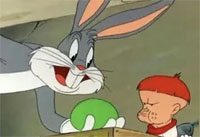 Bugs’ situation worsens when Elmer Fudd plots to trap the rabbit, but every trap fails. Of course. (Bugs’ attempt to distract Elmer with a “magic trick” is the work of McKimson). As Bugs flees from door to door (with frantic alternating scenes by Ellis and Kirsanoff), he finally succeeds in slamming Elmer’s head through the door, paints it like an Easter egg, and whistles for the Dead End Kid, who pounds on it with a hammer while screaming for Easter eggs, courtesy of animator Richard Bickenbach.
Bugs’ situation worsens when Elmer Fudd plots to trap the rabbit, but every trap fails. Of course. (Bugs’ attempt to distract Elmer with a “magic trick” is the work of McKimson). As Bugs flees from door to door (with frantic alternating scenes by Ellis and Kirsanoff), he finally succeeds in slamming Elmer’s head through the door, paints it like an Easter egg, and whistles for the Dead End Kid, who pounds on it with a hammer while screaming for Easter eggs, courtesy of animator Richard Bickenbach.
Thus, we take our leave of some of the nastiest brats of Golden Age animation. Birth control never sounded so good.